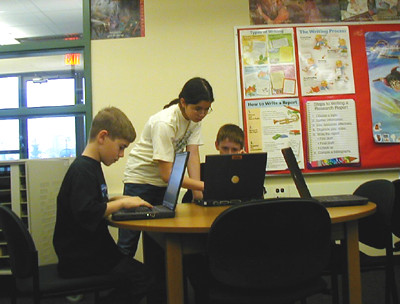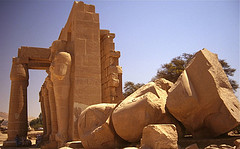Mixing molten lead and Blackberries
When I think of the technology of text, something like the image above (a small Goss newspaper press) usually comes to mind. The first time I saw one, I was impressed by the size and mechanical complexity of it. Later, when I met some of the older pressmen, they told me stories of the hot lead days–a few even had scars on their forearms from when the slugs (letter forms) would jam as they were sliding into place and, if the pressmen weren’t quick enough, hot lead would spray on to their arms.
Last week, I walked behind a student in the hall madly jabbing her thumbs at a tiny cell phone. The presses always made me think of the New York Times, democracy, mass distribution, and public debate. The cell phone makes me think: “c u l8tr” and a rendezvous at the mall. How does the medium shape the message?
September 20, 2009 No Comments
Ozy
One of my first memories of text as something interesting and powerful came from what I at first thought was a ‘dumb’ exercise in public speaking. My Grade 9 English teacher, an Englishman with a blue nose that we suspected was the result of a fondness for pints, required that we memorize and recite a short poem. He offered to help us choose something suitable, and in my case, suggested Shelley’s Ozymandias. As I read it over and over to memorize it, a funny thing happened: I started to like it, I started to appreciate its irony and world weariness. I recited it flawlessly, and can still remember it to this day (though, I admit, I looked it up online to check my memory before posting it below).
I met a traveller from an antique land
Who said: “Two vast and trunkless legs of stone
Stand in the desert. Near them on the sand,
Half sunk, a shattered visage lies, whose frown
And wrinkled lip and sneer of cold command
Tell that its sculptor well those passions read
Which yet survive, stamped on these lifeless things,
The hand that mocked them and the heart that fed.
And on the pedestal these words appear:
`My name is Ozymandias, King of Kings:
Look on my works, ye mighty, and despair!’
Nothing beside remains. Round the decay
Of that colossal wreck, boundless and bare,
The lone and level sands stretch far away”.
–Percy Bysshe Shelley
September 20, 2009 2 Comments
The future of reading?

ebooks kindle amazon, originally uploaded by libraryman.
I chose this image because it features the Kindle (a digital book reader) which combines two of the key preoccupations of the course: text and technology. Discussions about the Kindle were briefly the rage among technophiles at my school, until it became apparent that, at least initially, the device would only be available in the U.S.
I’m Phil, a teacher-librarian and journalism teacher at Centennial School in Coquitlam, B.C. I’m in my 10th year as full-time secondary teacher, after seven years in the Canadian newspaper business. My last newspaper job was working as a copy editor at the Toronto Star. I was born in Vancouver and raised in the Okanagan, so it didn’t take long before the desire to come home set in. I had moved to Ottawa to do a master’s in journalism at Carleton, and it was there, working as a TA in Journalism 100, that I started thinking about teaching as a career. A bleak Toronto winter sealed the deal. After earning my BEd at UBC, I started teaching English and journalism. At Centennial, the teacher-librarian asked if I would be interested in taking a library block to help with Internet and digital (then CD-based) resources, and in the years that followed I slowly picked up library blocks and dropped the English classes. I wasn’t too interested in pursuing an MEd in teacher-librarianship until recently when it became apparent that the role of technology was being more closely examined by TLs. I’m an early adopter, but also a skeptic. Technology is costly for schools and many of its affordances and non-monetary costs are poorly understood. As Postman pointed out in the Technopoly excerpt (which I confess I read from my print copy rather than the PDF), there are costs as well as benefits in all technologies. It seems the school community is populated with technophiles and technophobes, and an insufficient number of people willing to inhabit the murkier middle ground. This will by the final course in my program and I am looking forward to it. However, I was waitlisted and just given access last week, so my first task is to catch up with the rest of the class!
September 20, 2009 No Comments
My reflection
I love looking at the diverse collection of photos and submissions on this site! I find it fascinating how different each photo is, yet each still captures an aspect of communication through orality, text, and/or technology, many in ways I had never thought of. I have appreciated the insights and comments from my peers. As I read through Ong’s, “Orality and Literacy” I have pondered how our comments and posts would differ if we were all together discussing these topics face-to-face. I have found that when posting to the blog site, I usually just sit down and begin typing what comes to my mind, in a style more similar to how I would speak. In this way I feel that this weblog allows for such a high level of creativity by offering a comfortable and accepting (and perhaps more informal) learning community. I do find the threading aspect of the discussions within Vista a visually more pleasing method of connecting our discussions. However when writing a discussion to be posted in Vista I tend to rewrite and rework my passage much more than I do when posting a blog! I enjoy and appreciate the variety of methods (Weblog, Vista, Wiki) for sharing our thoughts and I have and would continue to use these methods with my students. I have found that my students love seeing their work, comments, projects, artwork (anything!) posted on a blog site for everyone to see.
September 20, 2009 No Comments
Classroom Writing – Korpan Intro

Luhrs Library, originally uploaded by ShipLibrary.
Trying to catch up on Module 1. Sorry for the late post.
I chose this photo as it represents my reality with text and technology in the classroom. We have classroom labs of 15 computers, as well as a mobile wireless cart in our schools. One of the constant issues is the appropriate and effective integration of information technology into the curriculum and instructional practises.
I am currently working in my fifth year as a K-12 Special Assignment teacher for St. Clair Catholic DSB in Southern Ontario. My previous classroom experience has been mostly at the grade 7/8 level. This is my 4th course in the MET program.
Among the many hats I wear in this role, I work closely with the District Literacy and Numeracy team of teachers in my board, as well e-Learning. My interest in this course stems from bridging that digital divide to transform teaching practises to include more digital literacies and electronic forms.
Sharon Korpan
September 20, 2009 No Comments
Module 1 Reflection: Collecting People, Collecting Knowledge
Last semester for ETEC*565, I created blog which housed my personal learning journey for the course. This was my first foray into blogging. From this experience I learned how important it is to regularly contribute to a blog in order to fully engage with the subject matter. As well I ended up with a nice snapshot of my growth over the course of the semester. Our Community Weblog takes a different approach in that all of us post to the same blog – a shift from building individual knowledge to creating distributed knowledge, built on collaborative and network literacies. This exposes all of us to diverse perspectives allowing each of us to construct new understandings of the topics raised. As our communal writing space archives all contributions, we will also be able to reflect back on our collaborative journey by the end of the course.
Postman (1992) states “new technologies alter the structure of our interests: the things we think about. They alter the character of our symbols: the things we think with. And they alter the nature of community: the arena in which thoughts develop” (p. 20). With our Community Weblog environment we can create a knowledge database with a structure that allows for spontaneity, the ability to link back to original sources and the ability to embed images and video to support our writings. The disorientating nature of the navigation differs so greatly from the linear ways of learning most of us are familiar with, thus it can be frustrating for many to determine where to start or how to proceed with participating.
On the other hand, the blog environment encourages us to push our understandings beyond text-to-text communication to create dynamic and flexible interpretations that we can continue to build on. Unlike our discussion forums, ideas are much more dispersed and are organized only by the tags and categories the participants employ. This allows for each individual to create their own connections and take responsibility for their own learning. The comments feature allows us to make connections and begin to tie ideas together. We all are responsible for the success of our shared space and thus participation will be essential throughout the semester for this to be a truly valuable experience.
On that note, with two sections contributing to the blog the amount of posts to-date is overwhelming – almost too many to keep track of. The search, tagging and category functions are absolutely key to being able to find information – somewhat of an organized chaos!
Karen Stephenson states that “experience has long been considered the best teacher of knowledge. Since we cannot experience everything, other people’s experiences, and hence other people, become the surrogate for knowledge. ‘I store my knowledge in my friends’ is an axiom for collecting knowledge through collecting people” (Stephenson, in Siemens, 2004, An Alternative Theory, para.1). As we all have different skills sets, experiences and knowledge we bring to the table, as a collective we are much stronger than we are on our own. Our weblog then becomes yet another link of our personal learning networks. It will be truly interesting to see how this space evolves over time.
References
Postman, N. (1992). Technopoly: The surrender of culture to technology. New York: Vintage Books.
Siemens, G. (2004). Connectivism: A learning theory for the digital age. Retrieved September 20, 2009, from http://www.elearnspace.org/Articles/connectivism.htm
September 20, 2009 No Comments
Reflections
I am impressed with the creativity of my fellow students and the openness of the professors to allow this freedom. As someone who is not very creative (!!!) I am learning that there is a great many ways to express ones ideas. I appreciate the effort that each person has gone into to post unique and interesting descriptions. In terms of using the community weblog as a learning platform I believe it lends itself to a more creative and open learning space. I do like that the entries are posted by date and tags and it is up to the person creating the post to ensure that they make the entry correctly. It will be fun seeing how this all develops.
Sarah
September 20, 2009 No Comments



